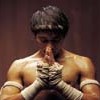Agam's Gecko


Sunday, October 14, 2007
STATE OF FEAR
"On our crowded planet, there are no longer any internal affairs. The Communists say, 'Don't interfere in our internal affairs. Let us strangle our citizens in peace and quiet.' But I tell you: Interfere more and more. Interfere as much as you can. We beg you to come and interfere."- Alexander Solzhenitzyn 1975
| B |
urma has been fairly described as a "state of fear" over the past four and a half decades. Right now, the state of this fear is probably at its highest point than at any time in the last two.
"It is not power that corrupts, but fear. Fear of losing power corrupts those who wield it and fear of the scourge of power corrupts those who are subject to it."Times UK has a correspondent inside the country, now sending dispatches from Mandalay. The correspondent's writing vividly conveys (in passages not quoted here) the mood of the city.-Daw Aung San Suu Kyi -- "Freedom from Fear"
Thousands of people are incarcerated in four detention centres around Mandalay controlled by the 33rd division of the Burmese army. Its commanders have broken the political power of the 200 monasteries here and shattered the Buddhist clergy as an organised force.More than half of Burma's 400,000 Buddhist monks reside in and around the city of Mandalay. On September 23, about a week after the monks had rekindled the movement with their leadership (after dozens of freedom activists had been swept up), the sangha leadership assembled in Sagaing, west of Mandalay. They remained resolute, rejecting offerings from the local military commanders, and planning for the next day's satyagraha, and a boycott of Chinese businesses.
They have instituted the severest repression inflicted upon this city for two decades.
On the 24th, more than 100,000 monks filled the streets of Rangoon -- two separate marches were said to number at least 130,000 in total. In Mandalay too, they came out in strength.
Ordinary folk prostrated themselves, stood on their balconies to clap their hands and gave drinking water to the monks as they passed.A lot of arrests were made during the crackdown, but many more have taken place since. If a citizen so much as smiled at the monks as they passed, and were caught on security camera and identified, they were apprehended (often in the middle of the night) and severely interogated. Students have been particularly targeted for hard prison time on fictitious charges.
Then came two ominous signs, for the military, that the Buddhist protest was spreading. First the monks were applauded when they walked through Muslim districts, prompting some of Mandalay’s young Muslims to join the protests.
There is desperate concern about five students from Mandalay’s medical university. The five, two girls and three boys, were arrested by soldiers after demonstrations at the campus. All are from well known, respectable families and several are popular figures among their peers.The fabled city of Mandalay is under the rule of the army's 33rd division, just transfered in from the war of genocide against the Karen people in eastern Burma.
“Their families are fearful because they have heard these kids will be charged with narcotics offences,” said an informant who has spoken to the youths’ relatives.
This will mean that instead of serving 40 days in detention for public order offences, the students could be sent to a notorious penal labour camp in the Hsu Kuang valley, northern Burma.
“It is hard to come out of there alive,” said the informant.
There are no reasons to expect clemency from the military in Mandalay. The 33rd division was transferred from Burma’s eastern border area where it campaigned against rebels from a minority ethnic group called the Karen. It has gained a reputation for rape, murder, looting and other unlawful violence against civilians.A number of student leaders from the 88 Generation (latest report is six) have been caught in the past couple of days. They have been the subjects of a manhunt since mid August, but had managed to elude capture until now.
The division is on a list of Burmese army units whose conduct is being investigated by several foreign governments. They have agreed to cooperate informally to document crimes against the population with a view to eventual prosecutions under international law.
For the foreseeable future, the 33rd’s commanders are free to run amok among the citizens of Mandalay. Their soldiers look seasoned, hatchet-faced and unemotional. Their uniforms are smart and their weapons are polished. They deploy in new Chinese military trucks and all-purpose vehicles.
Prominent leaders of the 88 Generation Students group, who led protests in August, were arrested at a hiding place in Rangoon on Saturday morning, said dissident sources.Most of these young freedom lovers had spent many years in prison already.
The leaders, who were arrested on October 12, were named as Htay Kywe, Mie Mie and Aung Thu. A fourth person, Ko Ko, who helped them hide, was also arrested last night, said the sources.
“The health of each of the former student leaders has already deteriorated since their previous prison term. So I would like to request the International Community again—please take real steps to stop the junta’s brutal acts and help the victims,” said Soe Tun [another 88 Generation leader, still in hiding who spoke to Irrawaddy].Bo Kyi is the Joint Secretary of the Assistance Association for Political Prisoners (Burma) [AAPPB is located in Mae Sot, Thailand]:
“The people of Burma have given their lives for democracy and hoped the international community would really help; but nothing has happened yet,” he added.
“These kinds of unjust arrests must be stopped. If not, the Burmese face more suffering,” said Bo Kyi. “Only statements without action from the UN Security Council will not stop the junta’s violent acts on Burmese citizens. We want to see more practical action from the Security Council.”The Burmese military buys its equipment from a strange list of countries.
Military-ruled Myanmar is a pariah state to many because of its dismal human rights record, slapped with an arms embargo by the U.S. and European Union. But to some of the world's other top weapons dealers, Myanmar is just another customer.As itemized in the graphic on that page, from 1988 - 2006, 12 nations sold $2.3 billion (mistake on AP graphic says "trillion") in conventional weapons to the Burmese military.
China 1.7 billion
Russia 396 million
Serbia/Montenegro 63 million
Poland 57 million
Ukraine 47 million
North Korea 10 million
Italy 9 million
Bulgaria 8 million
UK 8 million
Switzerland 4 million
Canada 2 million
India 2 million
Labels: Burma











 Our way of saying "thanks" in the Thai way. Here a nak muay Thai (kickboxer) offers respect and thanks for his teacher (wai khru) before a match. This is our local variation on the ubiquitous "hat tip" used in general blog culture.
Our way of saying "thanks" in the Thai way. Here a nak muay Thai (kickboxer) offers respect and thanks for his teacher (wai khru) before a match. This is our local variation on the ubiquitous "hat tip" used in general blog culture.




